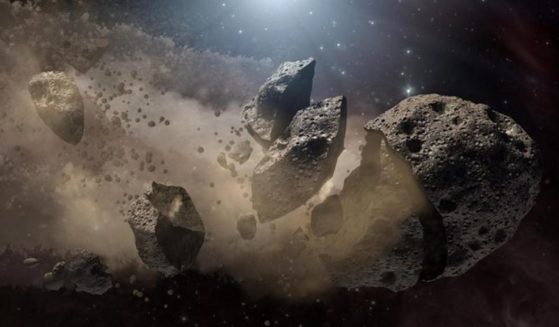US Tracking Chinese Rocket Bound for Uncontrolled Re-Entry Around Saturday
U.S. Space Command said Tuesday that a 46,000-pound Chinese rocket that is orbiting the planet is expected to make an uncontrolled fall into the atmosphere on or around Saturday, placing people and cities worldwide at risk.
The command said in a news release that it was “aware of and tracking the location of the Chinese Long March 5B in space” but would not be able to pinpoint the location at which it will fall into the Earth’s atmosphere “until within hours of its reentry, which is expected around May 8.”
This has raised concerns because no one knows the precise location where the debris will fall.
The debris from the rocket, as it disintegrates while breaking into the Earth’s atmosphere, could potentially land in the U.S., Mexico, Central America, South America, Africa, India, China, or Australia, according to CBS News.
SpaceNews reported the Long March 5B core stage’s orbital inclination of 41.5 degrees places it within range of possibly falling anywhere “farther north than New York, Madrid, and Beijing, and as far south as southern Chile and Wellington, New Zealand.”
The Russian space agency Roscosmos, like the Pentagon, said it believes the rocket will fall to Earth around Saturday but has ruled out any likelihood of the rocket’s pieces falling on Russian territory.
По данным Автоматизированной системы предупреждения об опасных ситуациях в околоземном космическом пространстве, вторая ступень ракеты Long March 5B, которая вывела модуль Tianhe китайской космической станции, осуществляет неуправляемый сход с орбиты: https://t.co/FYzz4YAl9u pic.twitter.com/aZ5C58AAKm
— РОСКОСМОС (@roscosmos) May 4, 2021
Until Space Command can determine where the debris will land, the agency said it would be regularly updating information on the rocket’s whereabouts on Space-Track.org.
.@18SPCS is providing daily updates to @SpaceTrackOrg on China’s Long March 5B location beginning today. https://t.co/f7FkNf1ixj #space #LongMarch5B #USSPACECOM
— U.S. Space Command (@US_SpaceCom) May 4, 2021
According to the most recent update on the website, Long March 5B was orbiting above the coordinates -27.7, 176.7, approximately 659.5 miles northeast of Auckland, New Zealand, and roughly 656.5 miles southwest of Fiji in the Pacific Ocean.
China launched the Long March 5B heavy-lift carrier rocket on April 29 from the coastal city of Wenchang in the Hainan province.
The rocket carried a 22.5-ton module, Tianhe — “Harmony of the Heavens” — for China’s first indigenous space station, Tiangong — “Heavenly Palace” — to a low-Earth orbit about 250 miles above Earth’s surface, according to the China National Space Administration.
After pushing the module into space, however, the 23-ton rocket remained in orbit.
Most launch rockets are not designed to go into orbit. Rather, they are designed to fall back to Earth through a predefined re-entry zone into a safe area.
But the Long March 5B has entered orbital velocity and is going around Earth every 90 minutes at about 17,324 miles per hour, passing over areas north of New York, Madrid and Beijing and areas in the Southern Hemisphere such as southern Chile and Wellington, New Zealand, according to SpaceNews.
CBS News reported that its high speed makes predicting where it will land nearly impossible.
As atmospheric drag pulls the rocket closer to Earth, the decay of its orbit will increase in a process that depends on the falling object’s size and density and other variables such as atmospheric variations and fluctuations.
When the orbit has sufficiently decayed, the rocket will drop to Earth. The rocket debris that survives the intense heat re-entering spacecraft experience while entering Earth’s atmosphere will most likely fall into oceans or uninhabited areas. However, there is a small chance they will fall onto inhabited regions of the planet.
This morning’s data on the altitude-versus-time of the Tianhe / CZ-5B objects. The core stage orbit continues to slowly decay as expected. pic.twitter.com/E8EPJ9yzRu
— Jonathan McDowell (@planet4589) May 4, 2021
“It is always difficult to assess the amount of surviving mass and number of fragments without knowing the design of the object, but a reasonable ‘rule-of-thumb’ is about 20-40% of the original dry mass,” Holger Krag, head of the European Space Agency’s Space Safety Programme Office, told SpaceNews.
“The Long March 5B core stage is seven times more massive than the Falcon 9 second stage that caused a lot of press attention a few weeks ago when it reentered above Seattle and dumped a couple of pressure tanks on Washington state,” astronomer Jonathan McDowell told the outlet.
“What’s bad is that it’s really negligent on China’s part. Things more than ten tonnes we don’t let them fall out of the sky uncontrolled deliberately,” McDowell said, according to The Guardian.
According to the outlet, since 1990, nothing exceeding 10 metric tons has been allowed to get into orbit and then re-enter the atmosphere uncontrolled.
Latest prediction from the Aerospace Corporation at 04:55 UTC today, reentry predicted for 04:07 UTC (00:07 Eastern) May 9 ± 24 hours. https://t.co/19yy3OxAeu pic.twitter.com/YlWFNIHJ4h
— Andrew Jones (@AJ_FI) May 5, 2021
“Last time [China] launched a Long March 5B rocket they ended up with big long rods of metal flying through the sky and damaging several buildings in the Ivory Coast,” McDowell said.
Last May, according to The Independent, a Chinese Long March 5B prototype narrowly missed hitting New York by 13 minutes as it fell into the Atlantic Ocean in a drop confirmed by the 18th Space Control Squadron.
Truth and Accuracy
We are committed to truth and accuracy in all of our journalism. Read our editorial standards.












